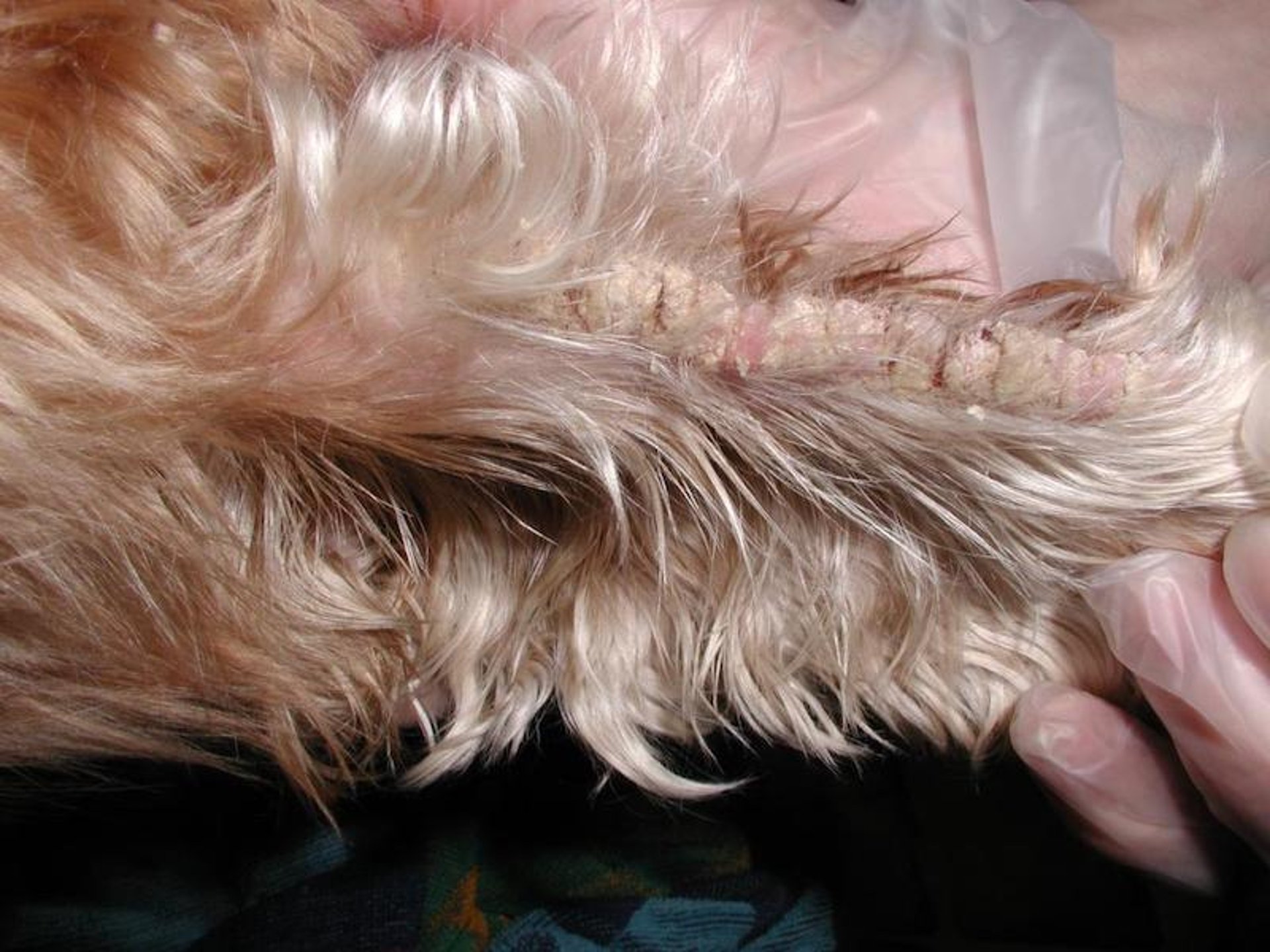Courtesy of Dr. Sheila Torres.
Sarcoptes scabiei is a common mange mite in pigs and dogs, and Notoedres cati (figure)is common in cats throughout the world. In the USA, sarcoptic mange is rare in horses and sheep and is a reportable disease.
Courtesy of Dr. Sandra Diaz.
Clinical signs may include:
papules
scaling
crusting
excoriations
severe pruritus
Transmission is by direct contact with infected animals or contaminated fomites.
Diagnosis is based on clinical signs, history, and discovery of mites, eggs or fecal pellets from multiple skin scrapings. Negative scrapings do not exclude the diagnosis, however, because mites are often difficult to find. If the diagnosis is suspected, treatment should be instituted. Mites are much easier to find on skin scrapings of cats with notoedric acariasis. Dermoscopy can also be used for mites identification; the mites mouth parts and the 2 proximal pair of legs appear as the characteristic "triangular sign" that resemble the triangular shape of a hang-glider.
Treatment options include:
isoxazolines (afoxolaner, fluralaner [available for cats], sarolaner [available for cats], lotilaner) are not labeled for scabies treatment, but have been shown to be effective. Use at label recommended dose. Although uncommon, neurologic adverse events like muscle tremors, ataxia and seizures have been reported with the use of isoxazolines containing products; use with caution in animals with history of seizures.
lime sulfur 2%–4% dips (safe in all species) every 5 days for 4–6 treatments
amitraz dips at a strength of 250 ppm (in dogs only) applied weekly for 4 to 6 treatments
ivermectin at 200–300 mcg/kg, PO or SC, every 1–2 weeks for 3–4 treatments
milbemycin oxime has been reported to be safe and effective in the treatment of sarcoptic mange in dogs but is not FDA approved for this purpose. Give orally 2 mg/kg once weekly for 4 to 6 treatments or twice weekly for 3 weeks.
selamectin , 3 applications 2 weeks apart are recommended. Check heartworm status before using.
moxidectin is not approved for the treatment of sarcoptic mange in the USA, but it is in other countries. Use at label-recommended dose. Check heartworm status before using.
Because mites can survive off the host for a variable amount of time, all bedding, brushes, tack, and fomites should be treated as well. All in-contact animals also should be treated because of the contagious nature of acariasis.
Ivermectin is widely used to treat sarcoptic mange in dogs and has been used to treat notoedric mange in cats, but it is not approved by the FDA for this indication. Therefore, every caution should be taken, and clients specifically informed of inherent risks with use of this drug. Dog breeds particularly susceptible to ivermectin toxicity include Collies, Shetland Sheepdogs, Australian Shepherds, English Shepherds, Longhaired Whippets, McNabs, Silken Windhounds, and Old English Sheepdogs; before using ivermectin, a genetic test for the mutation of the ABCB1 (formerly MDR1) gene, which encodes for the multidrug transporter P-glycoprotein, should be performed. (This test is available at the University of Washington.)
Nonburrowing psoroptic mites cause otitis externa in horses and goats. Animals may be asymptomatic or present with pruritus, head shaking, and a drooping ear. Crusted papules, alopecia, and/or scaling are typically present on the pinnae. Diagnosis is confirmed by finding the mites on a skin scraping or in otic exudate, but mites may be difficult to find in the ear canal. Ivermectin at 200 mcg/kg, PO, every 2 weeks for two treatments has been shown to be effective.
In pigs, control of sarcoptic mange should focus first on the breeding herd to avoid transmission to the piglets. Dams should be treated with external acaracide sprays or with an injectable avermectin 7-14 days prior to farrowing. Gilts should be treated 7-14 days before breeding. For boars, the frequency will vary depending on the exposure, but it is recommended to treat a minimum of 2 times a year. Feeder pigs should receive treatment before placement in a clean facility. Eradication programs usually start with culling of all severely infested breeding stock. Simultaneously, 2 consecutive doses of an injectable avermectin, 14 days apart, should be administered to every pig on the farm, any infected material (eg, bedding) should be disposed of, and a pesticide applied to the environment.
